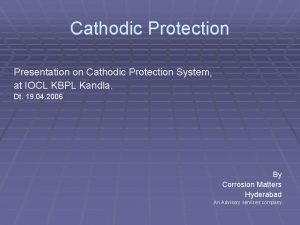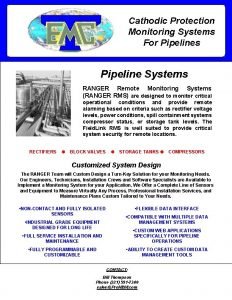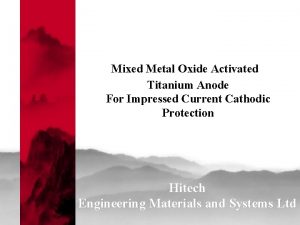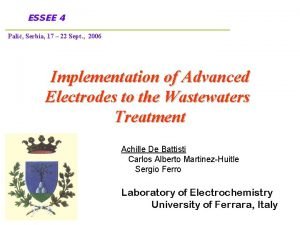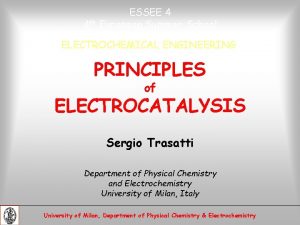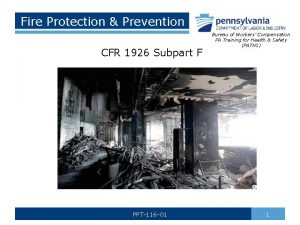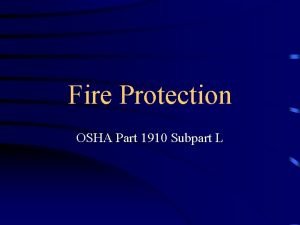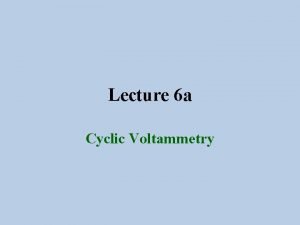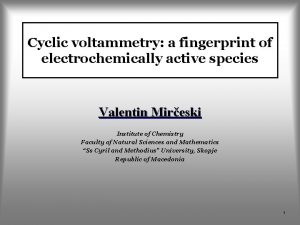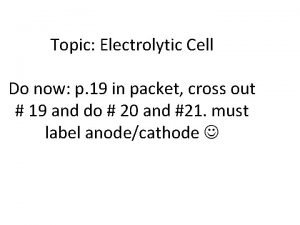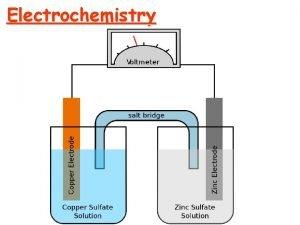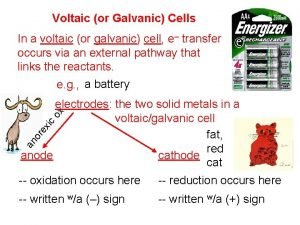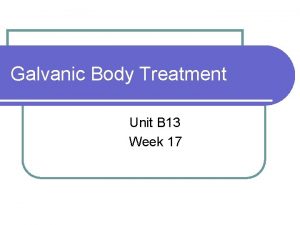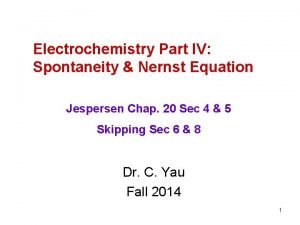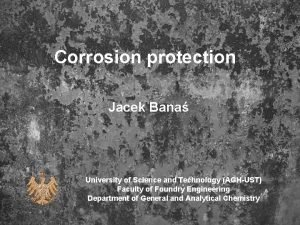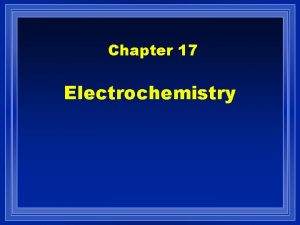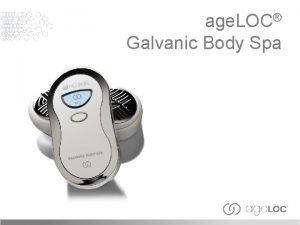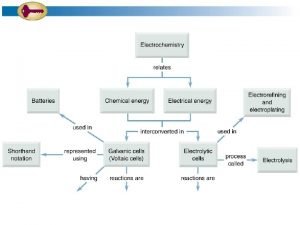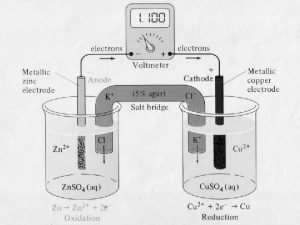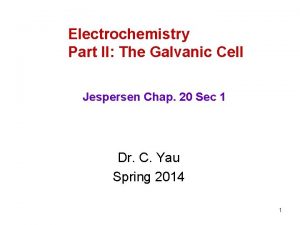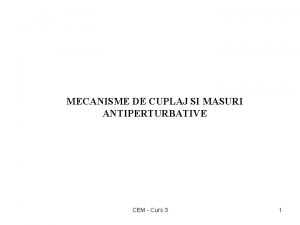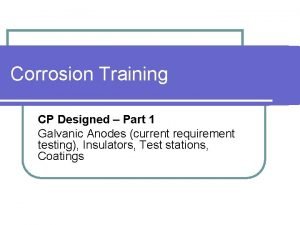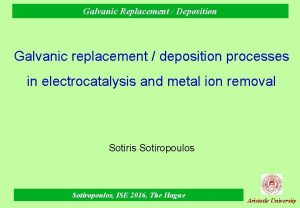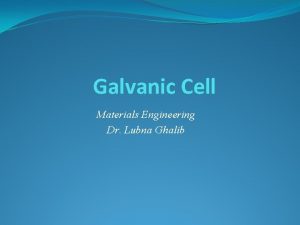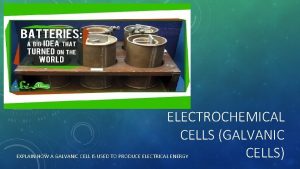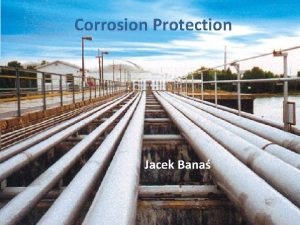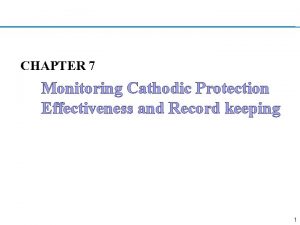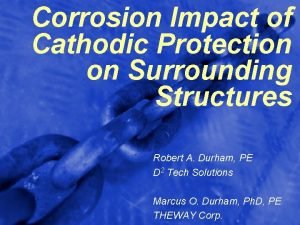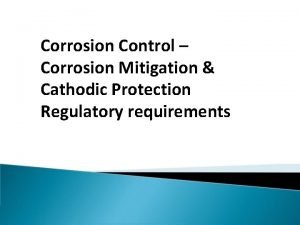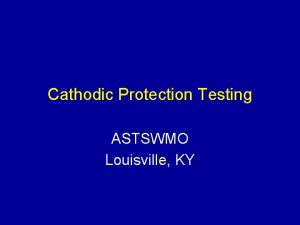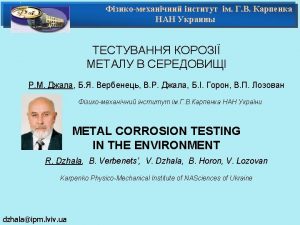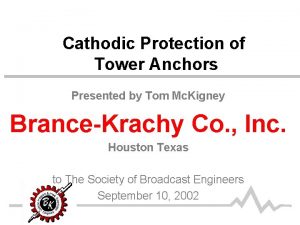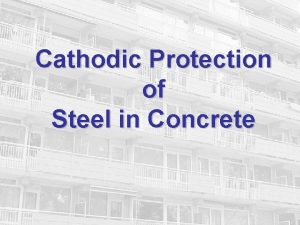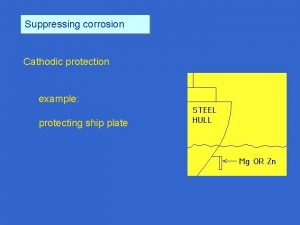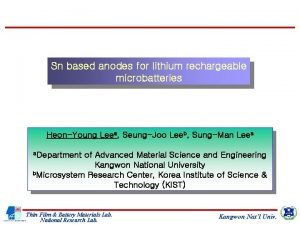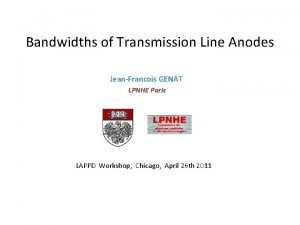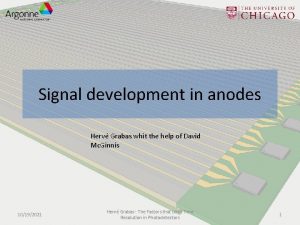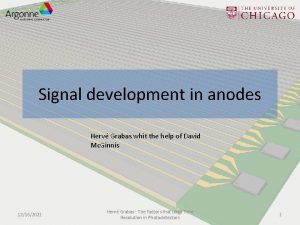Galvanic Anodes for Cathodic Prevention and Cathodic Protection



























- Slides: 27

Galvanic Anodes for Cathodic Prevention and Cathodic Protection Presenter Name C BCRC R P Figure 1

Rebar Electrochemical Behaviour +400 Potential (m. V vs SCE) Pitting Condition conducive to stable propagation of pits 0 A B D C E -400 Imperfect Passivity Allows pre-existing pits may propagate but new pits unlikely F Perfect Passivity -800 Initiation and propagation of pits inhibited Hydrogen Discharge Oxide unstable, hydrogen formed cathodically -1200 BCRC 0 0. 5 1. 0 1. 5 Chloride Content (wt % cement) R C 2. 0 P A B = Cathodic Prevention with low polarisation B C= Cathodic Prevention maintained as steel does not become active A D= Corrosion initiation due to chloride ingress D E= Corrosion continues with low polarisation Figure 2 E F= Additional polarisation for Cathodic Protection

Anodic and Cathodic Polarisation Zn Zn 2+ Fe Fe 2+ Log I/A Zn 2+ Zn -0. 79 V BCRC -0. 35 V Potential E Cathode: Anode Area Fe 2+ Fe C R P Figure 3

Cyclic Voltametric Polarisation Curves c) Selected Systems 0 to -900 mv acid) y l t h (slig aline) ZAP k l a ( ZAP 100 Steel 10 b)Polarisation Curves Various Systems 1 Zinc in Li. OH based mortar 0. 1 Expected Polarisation -800 -600 -400 -200 BCRC C R 0. 01 Polarisation [m. V Ag/Ag. Cl] Cathode Current Density [m. A/100 cm 2] a) Test Set Up P Figure 4

ZAP Electrolytic Paste and Gel Ø Auto-moistening formulation, slightly acidic but inert to concrete. Ø Thanks to its slightly acidic formulation : zinc will form zinc ions : Zn Zn 2+ + 2 e Ø Due to the electric field will attract chloride ions Ø Final reaction Zn 2+ + Cl- Zn. Cl 2 Ø Zn. Cl 2 is highly soluble and hygroscopic and will therefore inhibit zinc-passivation, which occurs in alkaline based electrolytes due to the formation of insoluble Zn(OH)2. C BCRC R P Figure 5

Zinc / ion-conductive adhesive Ion conductive adhesive gel Appr. 900 micron Zinc 99, 9% 250 micron 75 micron PET topliner Weight : Width roll : Length roll : Surface area per roll : BCRC 1, 750 kg/m 2 25 cm 25 m 6, 25 m 2 C R P Figure 6

ZLA Galvanic Anodes Advantages Ø As with other galvanic systems no wiring installation or external powersource needed Ø Simplest of any galvanic CP system to apply Ø Applied to surface so § Doesnt need coring to insert anodes § Prevents further penetration of contaminants Ø Provides high cathodic polarisation due to § the design of the ZAP § The very high anode : cathode area ratio Ø The high polarisation leads to § Good throw. Protects both rebar faces in thin elements § Ensures EN 12696 cathodic protection criteria are met Ø Full design possible as anode area know Ø Over 10 years experience BCRC C R P Figure 7

ZLA Galvanic Anodes Precautions Ø Clean, coating free concrete surface required Ø Avoid polymere based repair-mortars Ø Design system for each situation § Design life based on chloride penetration and anode: cathode ratio (typically 20 -40 years) ü SRCP galvanic anode design spreadsheet freely available § Waterproof system to protect ZAP ü Overcoated with approved coating where water exposed ü Seal exposed edges with approved sealant ü Seal leaking cracks through concrete C § Include coating resitance layer to extend life (>40 years) where large throw and low polarisation required BCRC R P Figure 8

C BCRC R P Figure 9

ZLA to Gouda Bridge Soffit, Netherland Repair at column support BCRC Connection of anode to rebar C R P Figure 11

Balconies at Dordrecht, Netherlands The structure before repair The repaired balcony with ZLA applied BCRC Slab after removal of drummy concrete & establishing rebar continuity ZLA after covering entire surface with 2 layers of Mapelastic Smart by roller Slab after pouring repair with rebar connection showing C R P Decorative finish after application of 2 layers of Mapei Elastocolour Pitura Figure 12

ZLA To Soffit of an Apartment Balcony Typical damage BCRC Patch Repair Finished Job P ZLA Application C R Figure 13

ZLA Protection of a Beam C BCRC R P Figure 14

ZLA Application to Bridge Application of ZLA to a bridge beam and column Finished ZLA application before coatings C BCRC R P Figure 15

ZLA Application to Bridge Columns Starting ZLA application During application of base coat BCRC After application of all ZLA After application of decorative coating C R P Figure 16

ZLA Rebar Connections & Fixings Mechanical Fixings (if Required) 1. Sheet fixed to concrete using adhesive backing 2. Holes drilled through sheet & concrete 3. Plastic nails hammered through ZLA into concrete where required. NB: the adhesive alone provides adequate fixity for applications where the consequence of a sheet falling off is low. On road bridges the consequence could be high and physical attachments is appropriate. BCRC Rebar Connection (option) 1. Sheet fixed to concrete using adhesive backing 2. Holes drilled through sheet, concrete and rebar 3. Metal nails hammered into steel at appropriate centres NB : Preference is to use full rebar connections C R Concrete metal nails P Figure 17

Polarisation Checking Circuits C BCRC R P Figure 18

Roll Anode & Anode Paste Roll anode showing foil layers and connection Drilling holes for Roll Anodes BCRC Zap cartridges Filling around the Roll Anode with ZAP C R P Figure 19

Roll Anode as Internal Anode Corroding Bar Patch where concrete is damaged. Clean rebar to bright steel in patch area. Prepare concrete surfaces in accordance with patch materials manufacturers recommended procedures Electrical connection between Roll Anode and rebar Roll Anode in electrolyte gel Chloride contaminated concrete P Corrosion protection of nearside bars C Corrosion protection of far side bars depends on proximity of roll anode R Existing ties provide electrical continuity BCRC Figure 20

Roll Anode As Internal Anode Chain of anode connections Connection to rebar Zinc Roll Anode C Electrolyte gel R Column reinforcing grid (links not shown for clarity) BCRC P Figure 21

ZLA to Gouda Bridge Beams C BCRC R P Figure 22

GSC Super Anodes Ø GSC Super Anodes § § GSC 10/10 – 100 mmx 55 mmx 12 mm GSC 10/20 – 100 mmx 55 mmx 15 mm GSC 30/10 – 300 mmx 50 mmx 10 mm GSC 30/12 – 300 mmx 50 mmx 12 mm Ø Packing GSC 10/10 § GSC 30/10 & 30/20 12 pcs/Carton § GSC 10/10 & 10/20 24 pcs/Carton Ø Storage § Shelf Life (nominal): 12 months. § Preferably temperature <30°C & RH<50% C GSC 30/12 BCRC R P Figure 23

GSC Super Anodes in New Structures Lightly reinforced columns Floor Slabs and Beams Heavily Reinforced Columns C BCRC P Ø Bridge deck or viaduct beam supports and columns Ø Bridge decks Ø Zones of newly casted concrete adhered onto an existing structure Ø Balcony facings and concrete facades Figure 24 Ø Floorings R

GSC Super Anode Ø Simple installation, needs no anode wiring. Hence low cost Ø Pre-stressed or post-tensioned tendons will not be subject to hydrogen embrit-tlement due to reasonable operating potentials Ø Need no service or monitoring Cathodic Protection Ø When proper designed will give enough current in dry and arid environments for 20 year life Ø When applied in aggressive environments the current densities are highly compatible with impressed current systems. Cathodic Prevention Ø Extremely adapted for patch repairs Ø Current densities are natural self-adjusting depending on the current request by the structure. Ø Low potential shift gives high protection but current density is low and anode life is long C BCRC R P Figure 25

GSC Super Anode Installation Ø Remove cracked and delaminated concrete Ø Tie on anodes and check electrical continuity. Resistance between anode and rebar should be less than 1 ohm. Ø At normal steel densities and for a design life of around 15 -20 years anode usage is: § GSC 30/10 & 30/20 anode 3 pcs/m 2 concrete § GSC 10/10 & 10/20 anode 4 pcs/m 2 concrete P Ø Reinstate with conventional patch materials with a resistivity as low as practically possible. C BCRC R Figure 26

Galvanic Anode Data Logger Turn knob to rotate through display options LED indicator LCD display (2 line display with 8 characters per line) for : • Date • Time • Channel 1 (mv) • Channel 2 (mv) • Channel 3 (mv) • Channel 4 (mv) SD memory card for data storage BCRC Start Depolarisation switch C R P Figure 27

Half Cells for Potential Measurement Ø ERE 20 Manganese Dioxide Electrode Ø 30 years of experience Ø Stable and robust C BCRC R P Figure 28
 Primary prevention secondary prevention tertiary prevention
Primary prevention secondary prevention tertiary prevention Deep well anode
Deep well anode Cathodic protection monitoring system
Cathodic protection monitoring system Marine italy
Marine italy Zinc ribbon ac mitigation installation
Zinc ribbon ac mitigation installation Mixed metal oxide anode
Mixed metal oxide anode Dsa anodes
Dsa anodes Dsa anodes
Dsa anodes Building fire protection ppt
Building fire protection ppt General industry subpart for fire protection
General industry subpart for fire protection Cyclic reversible process
Cyclic reversible process Cathodic peak current
Cathodic peak current Anode positive or negative
Anode positive or negative Oxidation and reduction in galvanic cells
Oxidation and reduction in galvanic cells What are redox reactions
What are redox reactions Electrolytic cell
Electrolytic cell Voltaic and galvanic cells
Voltaic and galvanic cells Galvanic facial aftercare advice
Galvanic facial aftercare advice Nernst equation simplified
Nernst equation simplified Galvanic element
Galvanic element Khan academy balancing equations
Khan academy balancing equations What happens at the cathode in a galvanic cell
What happens at the cathode in a galvanic cell Galvanic body spa results
Galvanic body spa results Galvanic cell picture
Galvanic cell picture Leclanche cell anode and cathode reactions
Leclanche cell anode and cathode reactions Galvanic body spa funciona realmente
Galvanic body spa funciona realmente Line notation electrochemistry
Line notation electrochemistry Cuplaj galvanic
Cuplaj galvanic

